
A unique dinosaur exhibition that collects only dinosaur art centered on paintings, not fossils and skeletal specimens, a special exhibition "Dinosaur Picture Book-Imagination / Creation of the Lost World" May 31, 2023 (Wednesday)-7 It is being held at the Ueno Royal Museum on Saturday, March 22nd.
This exhibition draws attention for its large number of works by Charles R. Knight and Zdenek Briand, two of the greatest dinosaur paintings of the 20th century. Report on the state of the venue.

Venue entrance
When we think of dinosaur exhibitions, we usually think of exhibits centering on fossils and skeletal specimens, but in this exhibition , we draw paleontological creatures such as dinosaurs based on scientific evidence such as fossils, which are usually placed beside those materials. The spotlight is on ecological reconstruction map = "Paleoart" .
Dinosaurs, which ruled the earth in the Mesozoic Era from about 250 to 66 million years ago, came to be known to the general public through ecological reconstruction maps following the excavation of fossils in the first half of the 19th century. Since then, many scholars have worked hand-in-hand with artists to try to reproduce the appearance of ancient creatures full of romance from ancient times.
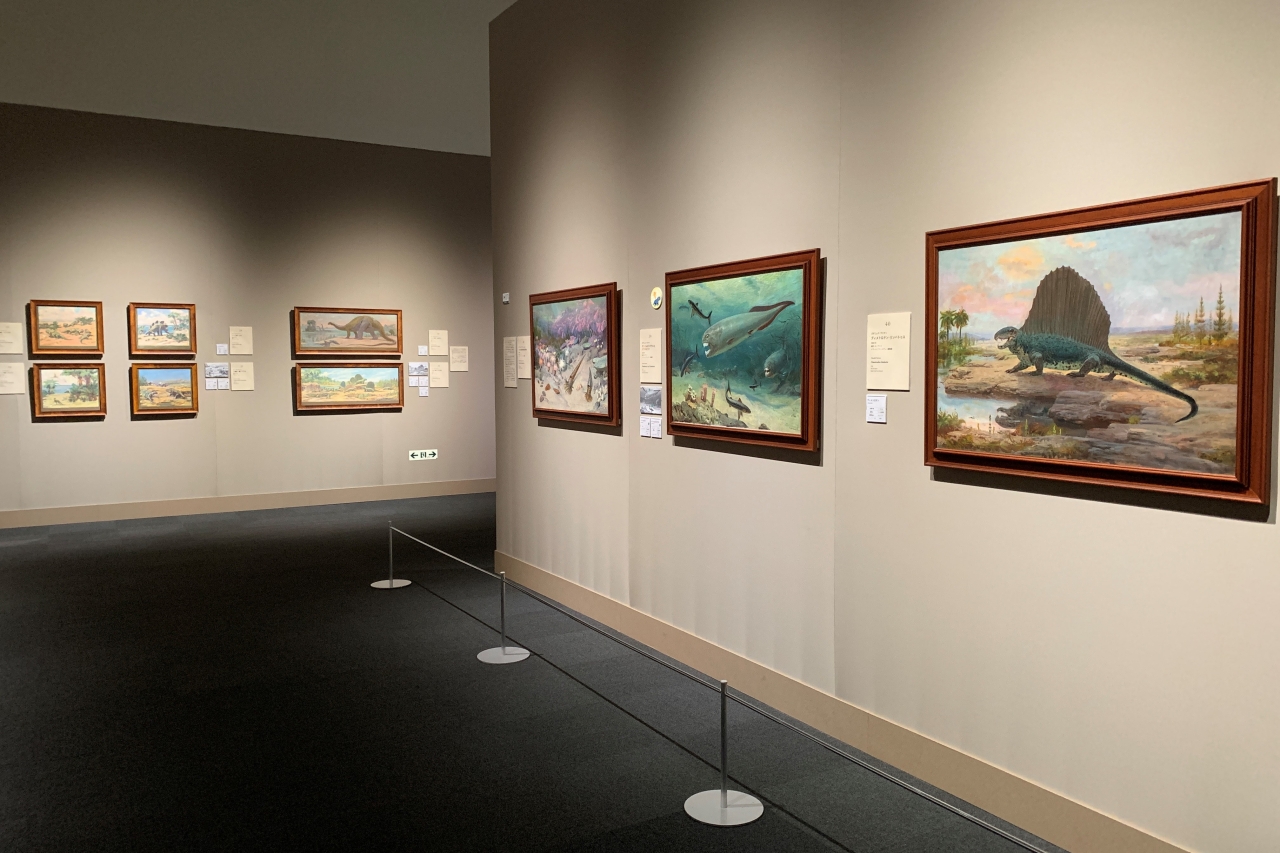
Exhibition view
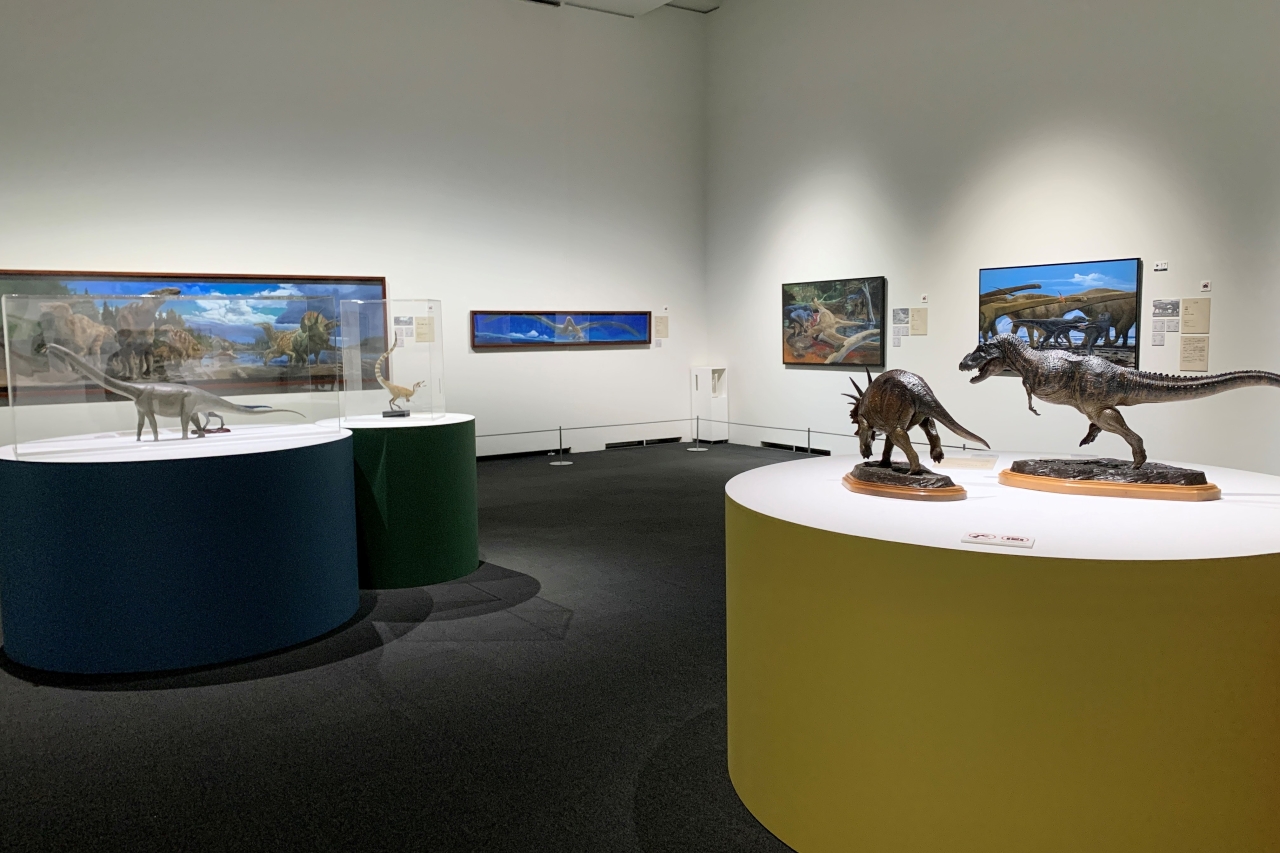
Exhibition view
At the venue, about 150 pieces of paleo art collected from all over the world will be displayed, ranging from strange reconstruction drawings drawn in the early days to masterpieces by contemporary artists based on recent research.
In the 200 years since the "discovery" of dinosaurs until today, we will trace how the expressions of dinosaurs (paleontology) have changed as the scientific basis changes with each new discovery.
Chapter 1 "The Birth of Dinosaurs – Strange Monsters of the Dawn"
The exhibition consists of four chapters. Chapter 1, "The Birth of Dinosaurs – Strange Monsters of the Dawn" introduces a group of works created with limited knowledge shortly after the "discovery" of dinosaurs in the 19th century. You can enjoy a unique appearance that is far from the dinosaurs that we imagine in our minds.
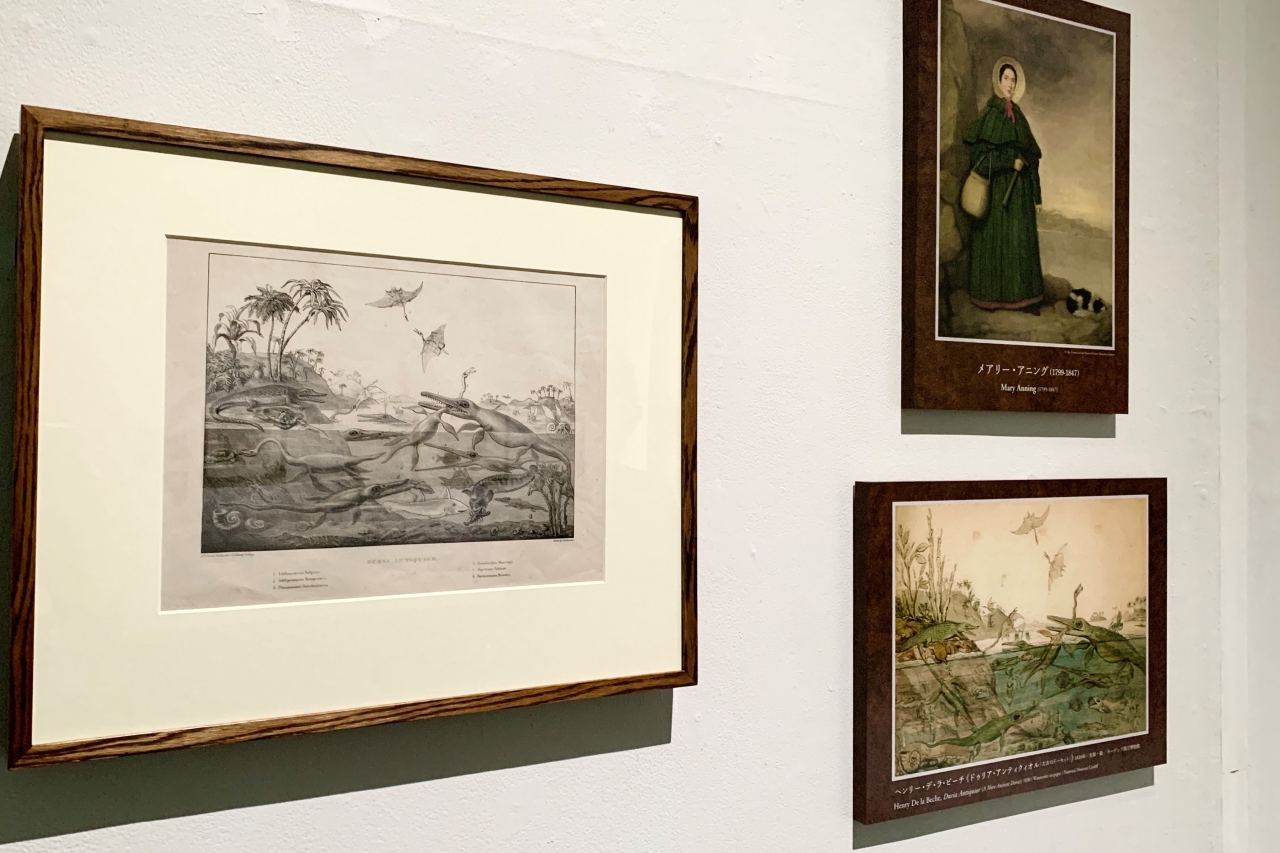
Left/George Scharf (by Henry de La Beech), Douria Antiquiol (Ancient Dorset), 1830, Natural History Museum, London
At the beginning, the lithograph "Douria Antiquiol (Ancient Dorset)" (1830) based on the original painting by geologist Henry de La Beach, is said to be one of the first paintings in history to restore the ecology of paleontology. Display your work.
The work is a female fossil collector known for contributing to the development of paleontology in the 19th century by discovering marine reptiles such as the ichthyosaur Ichthyosaurus and the plesiosaur plesiosaur before the dinosaurs in Dorset, southern England. It was made to honor the achievements of Mary Anning .

In this exhibition, in addition to the lithograph, a large oil painting that is an enlargement of the lithograph will also be exhibited. / Robert Farren, Creatures of the Jurassic Sea—Douria Antiquiol (Ancient Dorset), c.1850, Sedgwick Earth Science Museum, University of Cambridge
Set on the prehistoric coast of Dorset, it is filled with ancient creatures discovered by Anning. Attention is drawn to the right side of the screen, and it seems that the Ichthyosaurus is biting the thin neck of the Plesiosaurus.
Hiroki Okamoto (Professor at Kobe Design University and former curator at the Hyogo Prefectural Museum of Art), the organizer of this exhibition, said, "From modern research, it's hard to imagine an ichthyosaur attacking a plesiosaur. It conveys that there was an image of a predator that was overwhelmingly stronger."
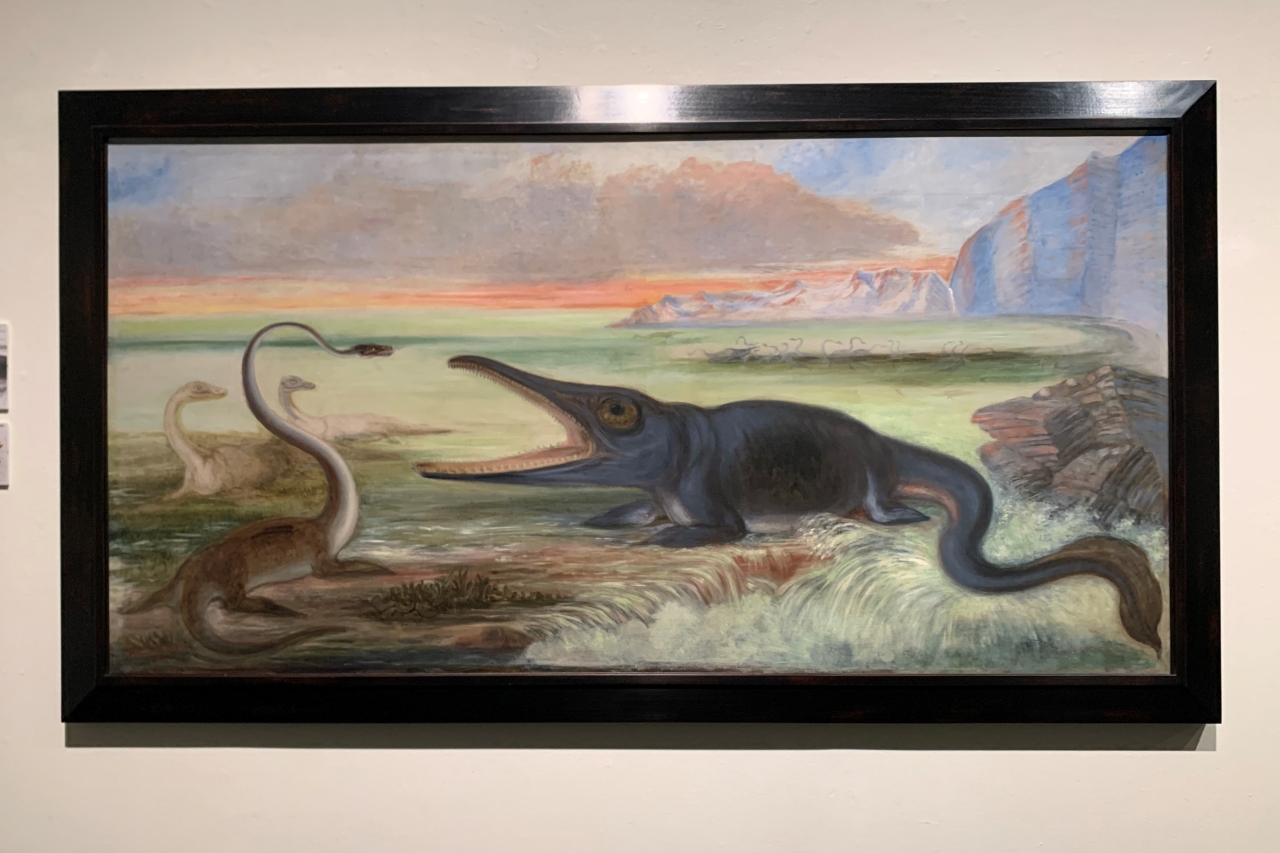
Even in the 1876 work, Ichthyosaurus is still bullish against Plesiosaurus. The folded legs of the Ichthyosaurus are strangely cute. / Benjamin Waterhouse Hawkins, Marine Reptiles of the Early Jurassic, 1876, Princeton University, Department of Geosciences, Guyot Hall

This Ichthyosaurus is blowing tide from its head like a whale. / Edouard Liou, Ichthyosaurus and Plesiosaurus (Rias Stage) (Illustration from Louis Figuier's "Earth before the Flood" (2nd edition, 1863), 1863, private collection
In addition, this exhibition focuses on introducing the evolution of the image of Iguanodon , the first dinosaur to be “discovered” along with Megalosaurus.
British physician and amateur geologist Gideon Mantell, known as "the man who discovered the dinosaurs", named it "Iguanodon" (iguana tooth) in 1825 because it had teeth similar to those of the modern reptile Iguana. It seems that this creature was originally imagined as a gigantic iguana.
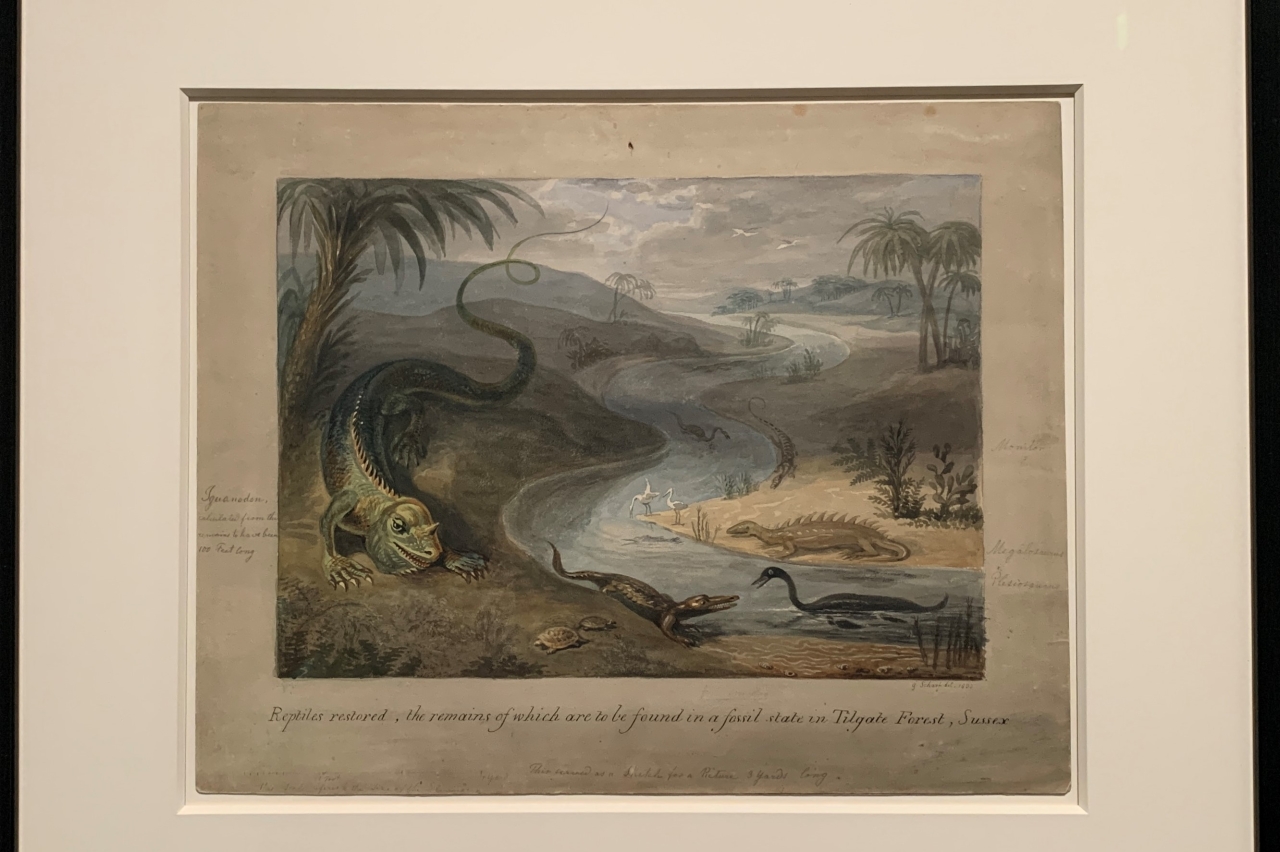
George Scharf, Reconstructed Reptiles Based on Fossils Found in Tilgate Forest, Sussex, 1833, Alexander Turnbull Library, Wellington
An early example of an Iguanodon, George Schaaf's Reconstructed Reptile (1833), depicts an exceptionally large Iguanodon with its enormous body crawling on the ground and its long, snake-like tail undulating.
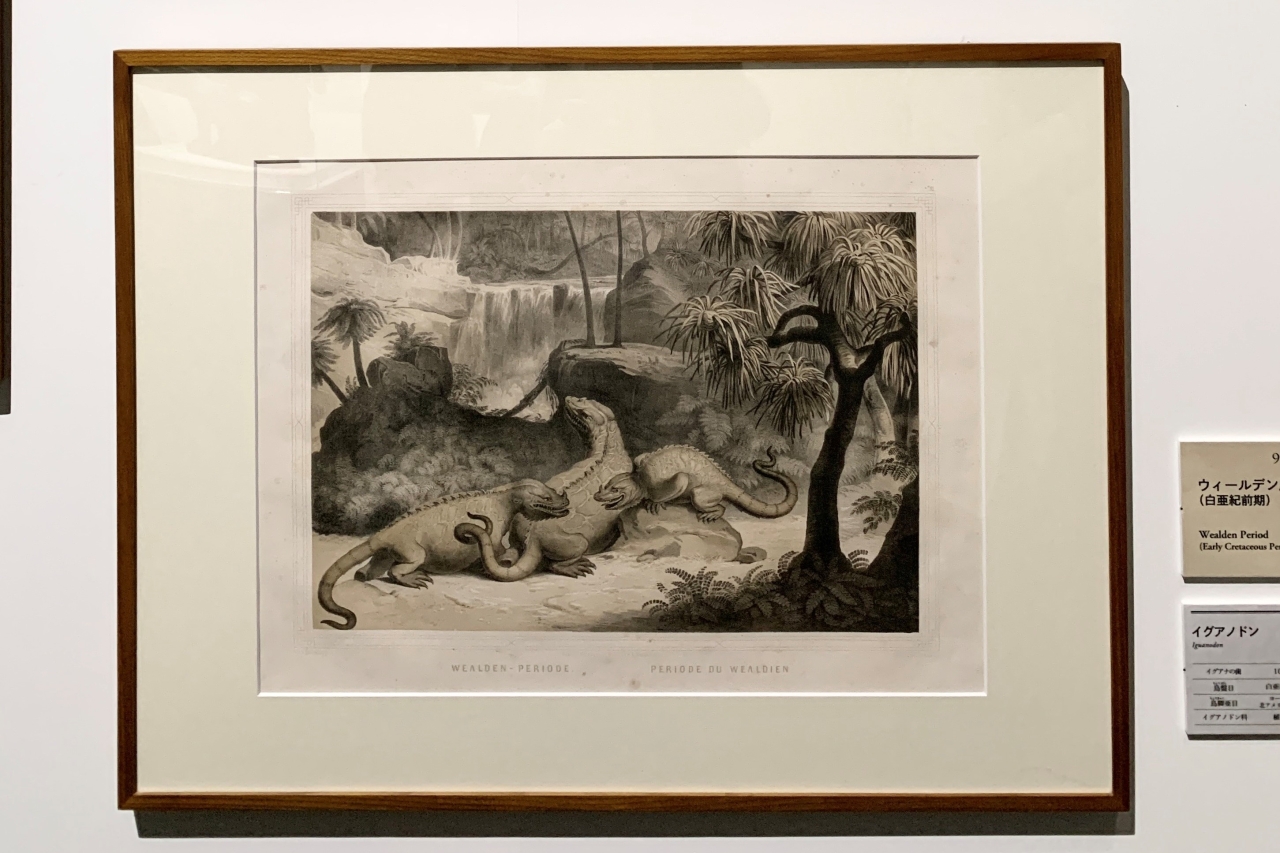
Iguanodon, drawn under the guidance of Austrian botanist Franz Unger, is also an image of a creature crawling on the ground. / Josef Kvasek, Franz Unger – "The Primitive World in Various Formative Periods", Wielden Group Period (Early Cretaceous), 1851, Eric Buchteau Collection
However, if you look at the sculpture Iguanodon of the Crystal Palace produced around 1853, the image has undergone a minor change. Iguanodon's four legs descended straight from its body to the ground like mammals such as elephants and rhinos.

Benjamin Waterhouse Hawkins, Iguanodon (Maquette) in the Crystal Palace, c.1853, Natural History Museum, London
It was created under the guidance of Richard Owen , the most influential British paleontologist of the time and the person who coined the word "dinosaur" . According to Okamoto, this physical feature is one of the current definitions of dinosaurs.
Furthermore, the discovery of near-perfect Iguanodon fossils in a Belgian coal mine in 1878-80 greatly revised the image of the Iguanodon reconstruction that had spread for nearly 50 years since Mantell's discovery. Especially. It turned out that it was erecting its upper body, and that the bones previously thought to be the snout horns were actually thumb spikes on its forelimbs.

A reconstructed skeleton of an Iguanodon. / Leon Becker, 1882, Restoration of Bernissar's first Iguanodon in the Chapel of St. George in Nassau Palace, 1884, Royal Belgian Museum of Natural History, Brussels
For nearly 100 years, Iguanodon was depicted in paleo art as a bipedal creature with sharp spikes on its forelimbs. In the following chapters 2 and 4, you can see works depicting the appearance of Iguanodon that "evolved" while being modified in this way.
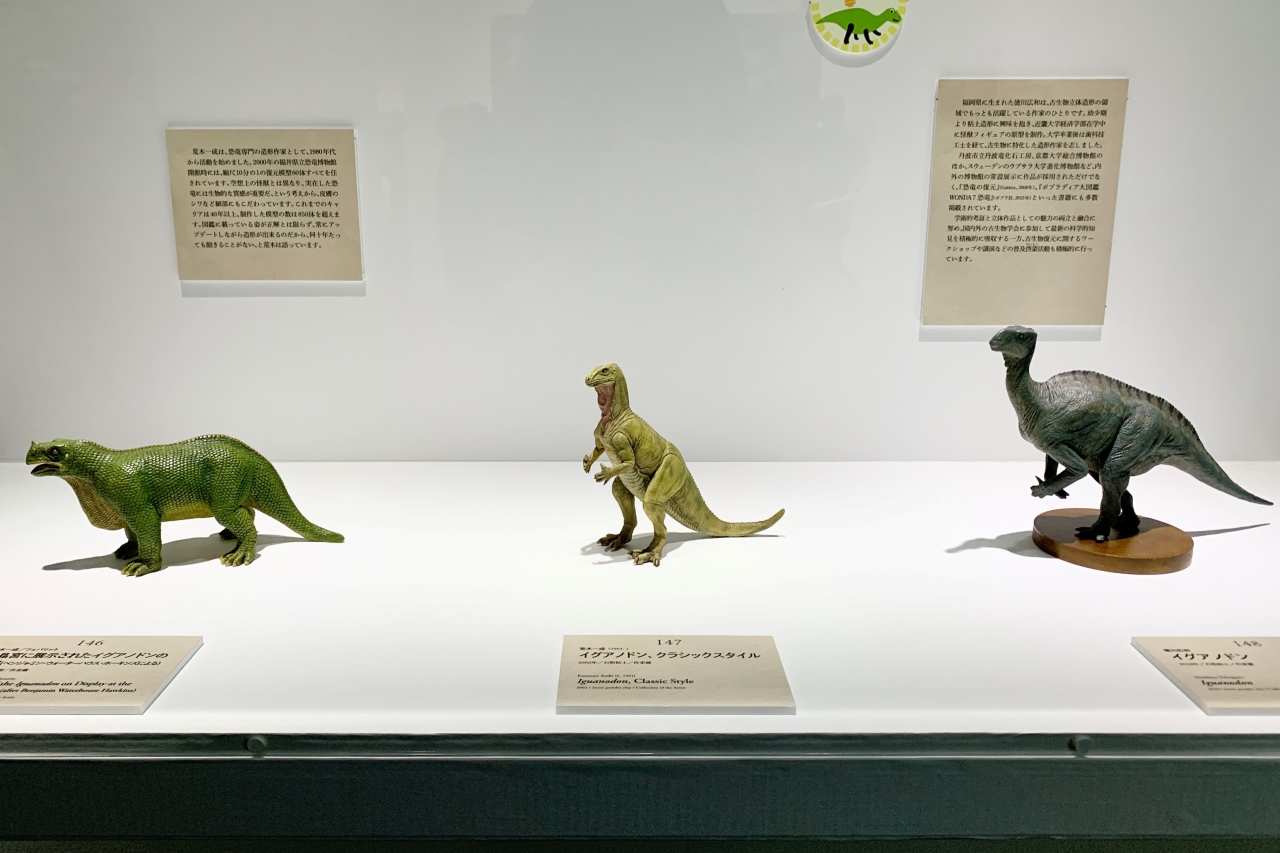
A restored statue that traces the evolution of the image of Iguanodon is also on display.
In addition, in Chapter 1, eerie dinosaurs that look and behave like humans are disgusted by their friends who are being attacked and retreat, or walk around the residential area like a monster movie. It is interesting that there are works that depict dinosaurs more like story paintings than restoration paintings. It was a glimpse of the people's fluffy perception of dinosaurs and the richness of their imagination at the time.
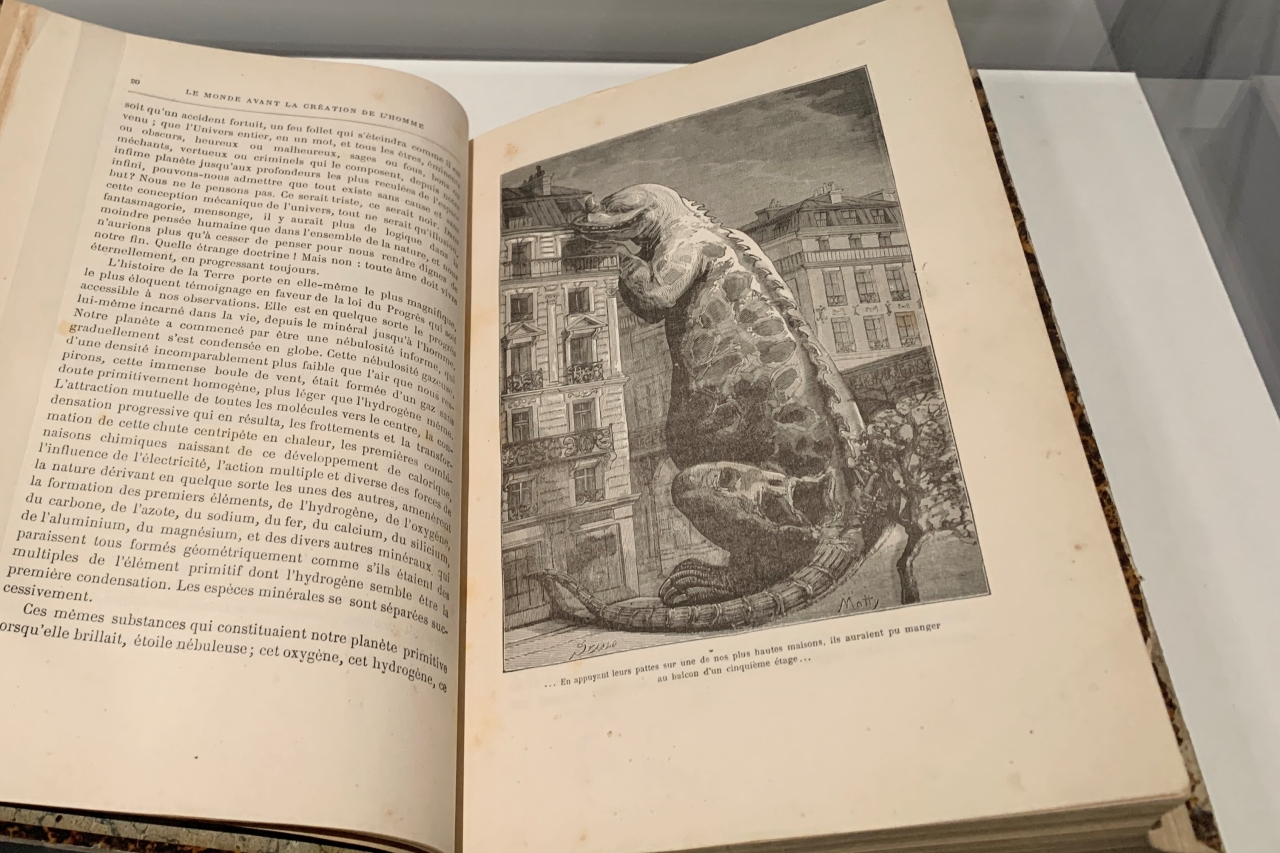
《If you put your front foot on a high-rise house, you might be able to eat on the balcony on the 6th floor》 (Camille Flammarion, The World Before the Birth of Man (1886), illustration), 1886, Eric Buffeteau Collection
Chapter 2 “Establishment and Popularization of Classical Dinosaur Images”
In Chapter 2, "Establishment and Popularization of Classical Dinosaur Statues," which introduces works from the golden age of paleo art from the end of the 19th century to the middle of the 20th century, Charles R. and Zdeněk Briand have a lot of space.

Chapter 2 Installation view, works by Charles R. Knight
The stage for dinosaur excavation and research gradually shifted from Europe to the North American continent, and from the 1870s to the 1890s, two paleontologists fought a fierce battle called the "Bone Wars" over the discovery of dinosaur fossils. We waged a competition. As a result, numerous types of dinosaurs such as Stegosaurus and Triceratops were found, revealing the diversity of animals that lived in the Mesozoic Era.
Charles R. Knight (1874-1953), an American paleontology painter, was the greatest contributor to the realistic visualization of new dinosaurs that had taken off the veil of the unknown and popularized them.
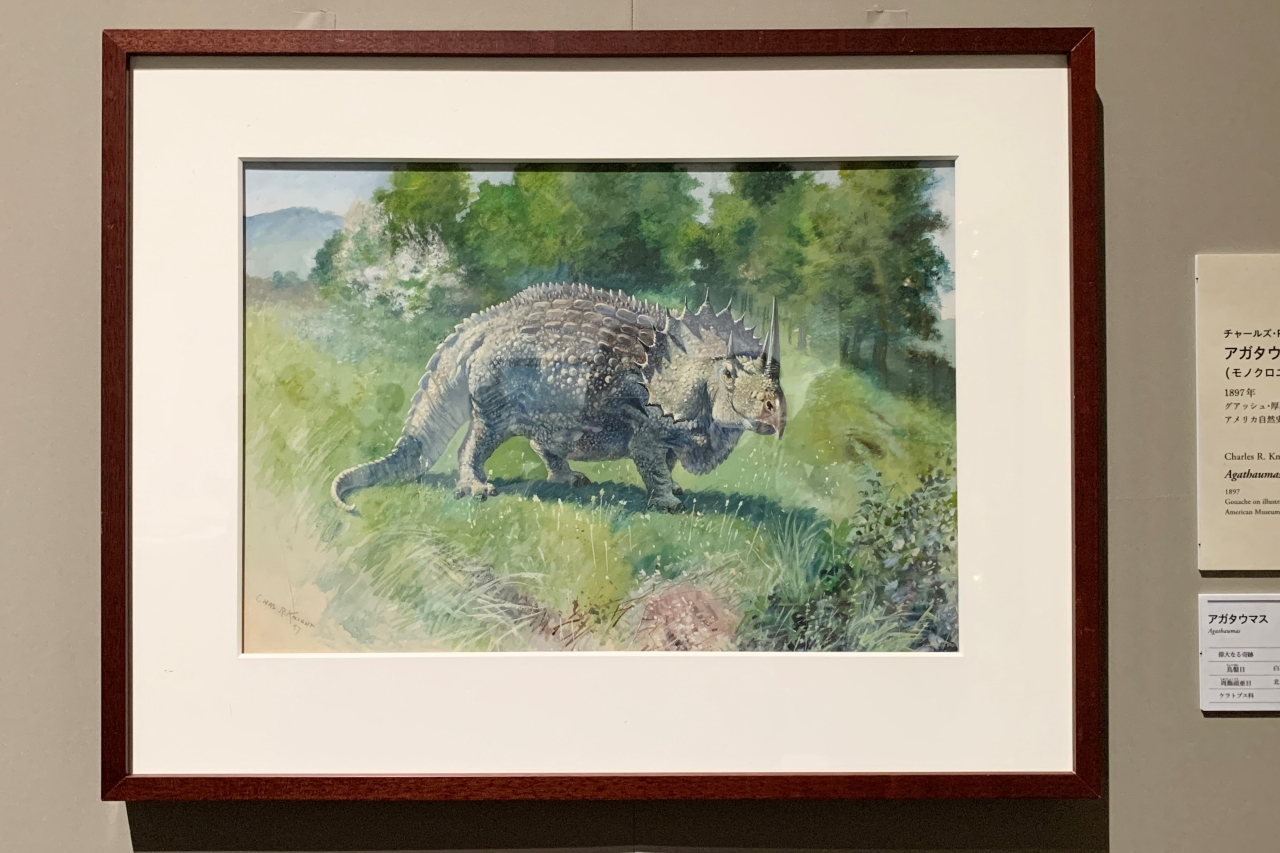
Charles R. Knight, Agathaumus sphenocerus (Monoclonius), 1897, American Museum of Natural History, New York

Knight's Early Masterpiece / Charles R. Knight, Dryptosaurus (Leaping Laelaps), 1897, American Museum of Natural History, New York
Knight, who was also a wildlife painter, left nearly 1,000 paintings of living animals, and it is believed that the observational eyes and biological knowledge cultivated through such activities were useful in the creation of paleo art.
Knight's realistic landscapes, and the lively figures of dinosaurs and extinct creatures placed within them, were excellent for the time in terms of both anatomical and natural environment depictions, and soon became popular. It has attracted the attention of both the general public and experts. His work had an impact on film culture, such as the movies "The Lost World" (1925) and "King Kong" (1933).
In the exhibition of Knight's work, one of his greatest masterpieces , Cretaceous-Montana (1928), one of the sketches for the murals of the Field Museum of Natural History, cannot be overlooked.
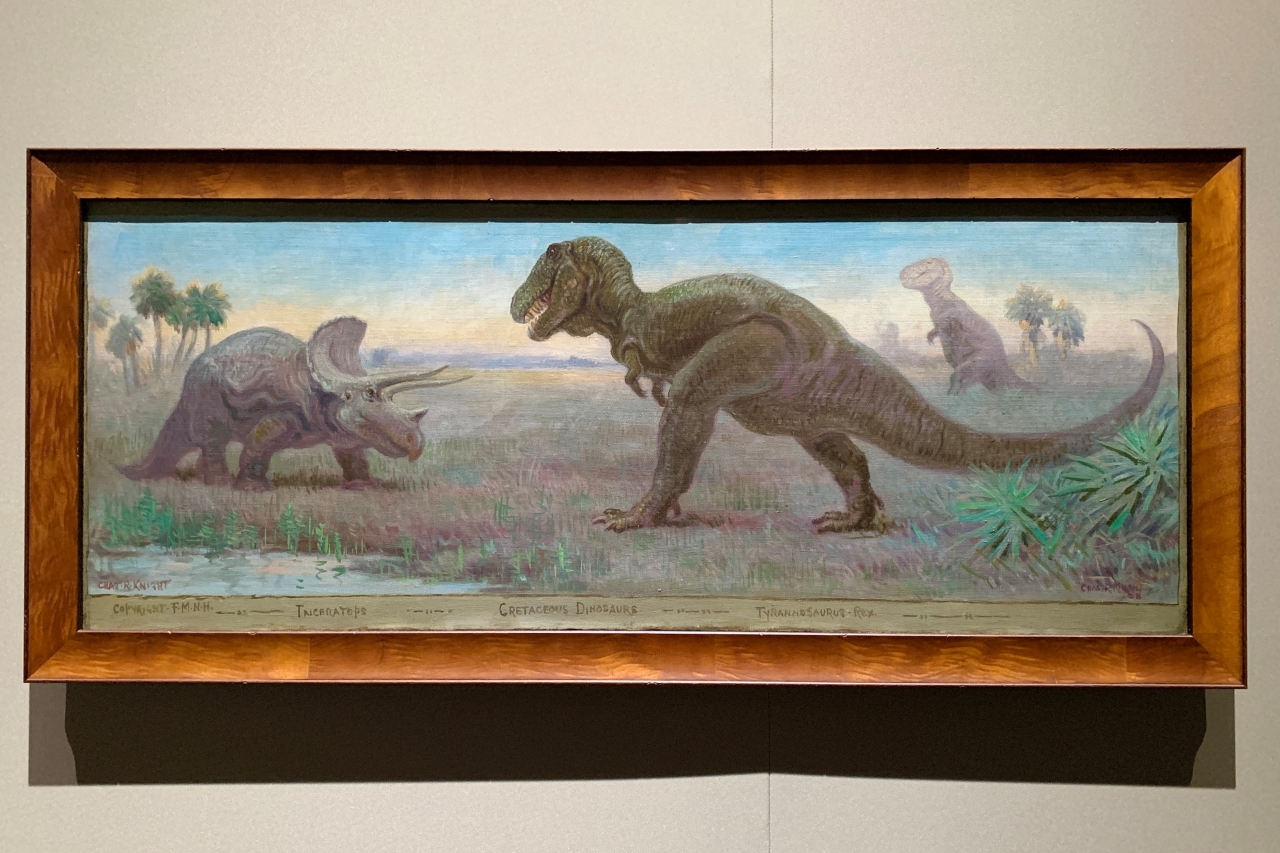
Charles R. Knight, Cretaceous-Montana, 1928, Princeton University
"Cretaceous-Montana" is a monumental work that fixed the image of the rivalry between the stars of the dinosaur world, "Tyrannosaurus vs. Triceratops," and has become widely known as a work that symbolizes dinosaur painting itself. The tense composition has been imitated and adapted by many subsequent artists, and it often appears in the entertainment world such as movies and comics, so many people should have seen it at least once. I was deeply moved that this was the original.
On the other hand, Zdenek Brian (1905-1981), a painter from Czechoslovakia (now the Czech Republic), gained popularity in a generation slightly after Knight.
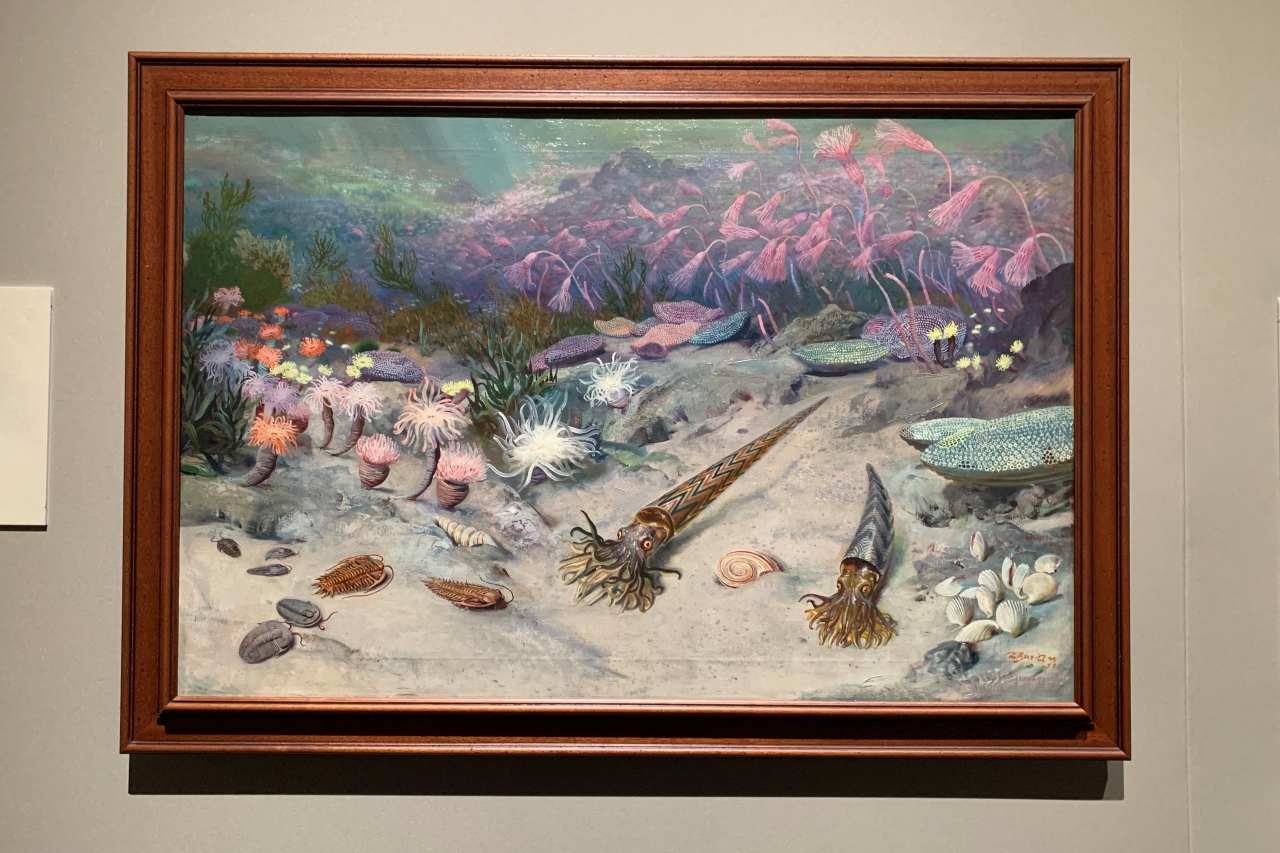
Zdenek Briand, Silurian Sea Creatures, 1951, Dvor Kralove Zoo
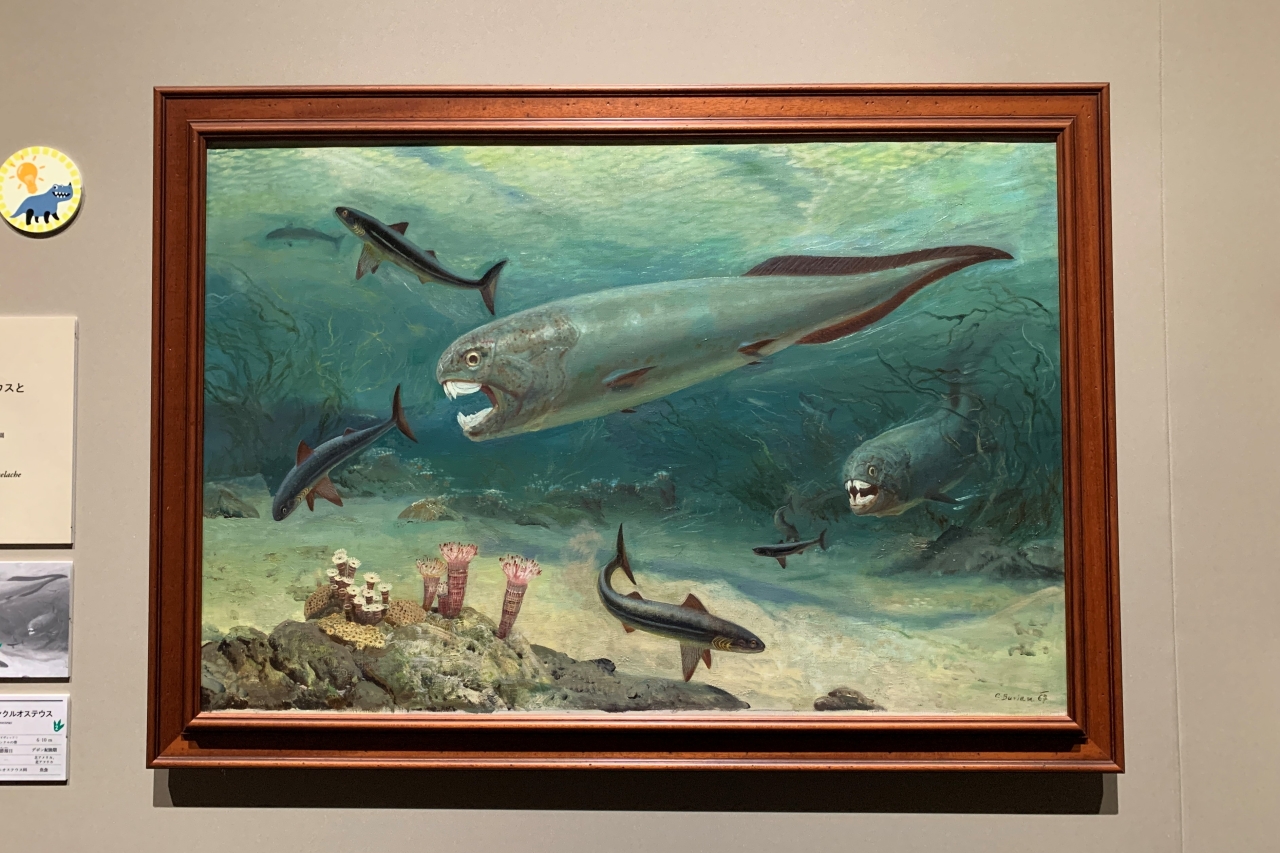
Zdenek Briand, Dunkleosteus and Cladoselake, 1967, Dvor Kralove Zoo
Although Knight's work was a departure from the unrealistic paleo art of the previous era, Briand was also an excellent painter. His works, based on the tradition of realism in European art, were so persuasive that you might believe it if you were told that he had actually seen the real thing and painted it.
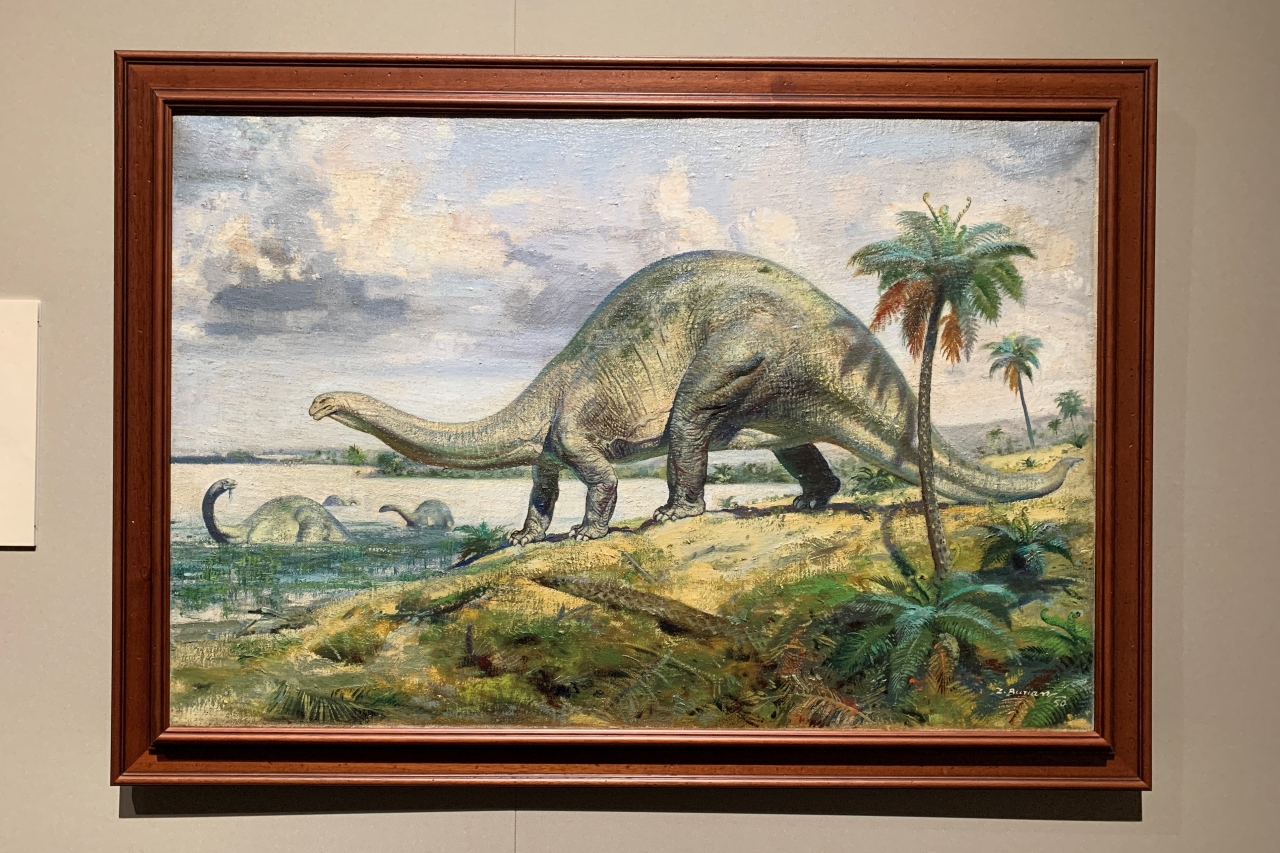
One of the attractions of Briand's work is the detailed depiction of wrinkles on the skin that cannot be imagined. / Zdenek Briand, Apatosaurus excelsus, 1950, Dvor Kralove Zoo

Zdenek Brian, Plesiosaurus brachypterygius, 1964, Dvor Kralove Zoo
Looking at the paleontological creatures that Brian draws, they naturally have a body temperature, and you can tell that they are living creatures.
Briand's works gained popularity around the world with books such as the masterpiece "Breaks of the Last Century" (1956), and were reproduced and copied in large numbers in children's encyclopedias and children's books here in Japan in the 1960s and 1970s. , is said to have played a decisive role in establishing the image of dinosaurs of an era. For this reason, people of the generation who were obsessed with dinosaur encyclopedias during this period may find a lot of works that make them feel like they've seen this somewhere before.
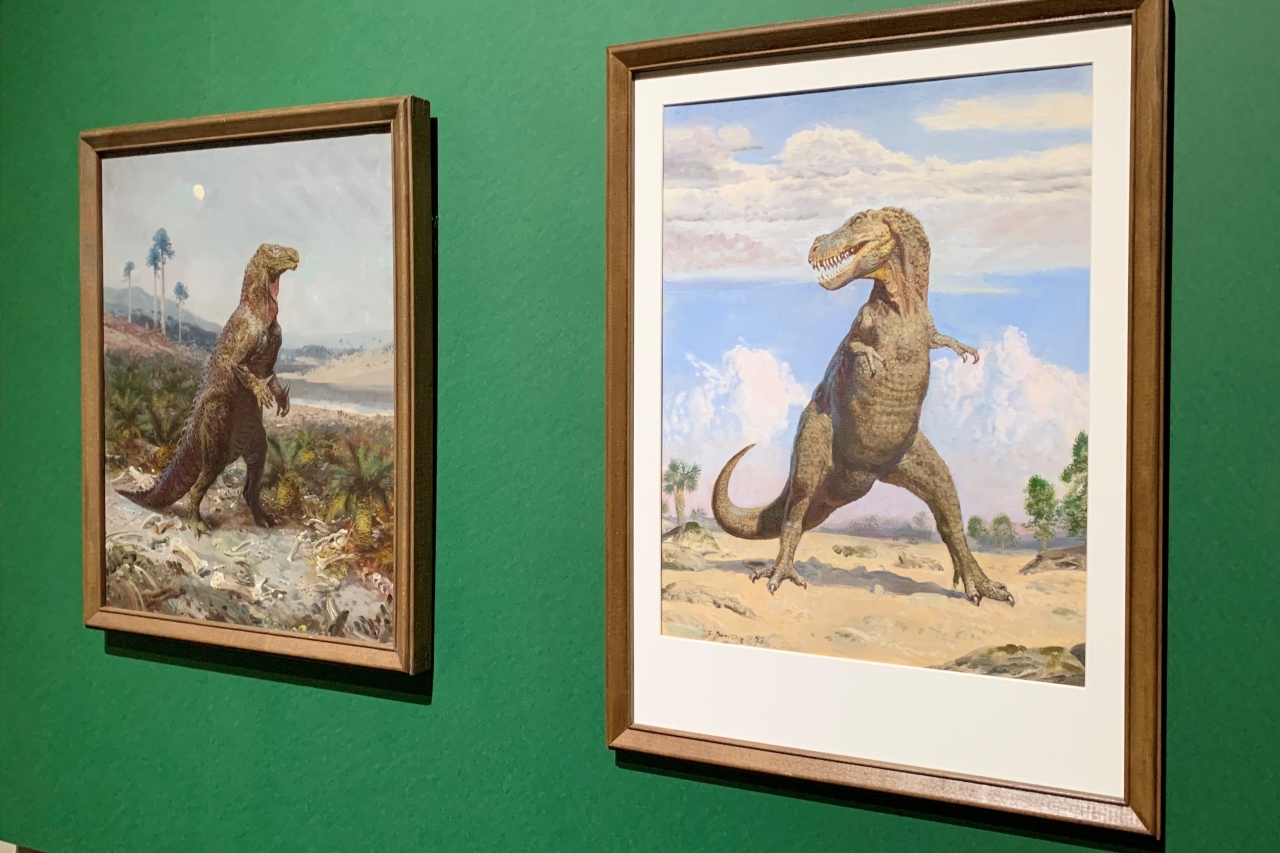
Left/Zdenek Brian, Iguanodon bernisartensis, 1950, Moravian Museum, Brno
Right/Zdenek Brian, Tarbosaurus Batal, 1970, Moravian Museum, Brno
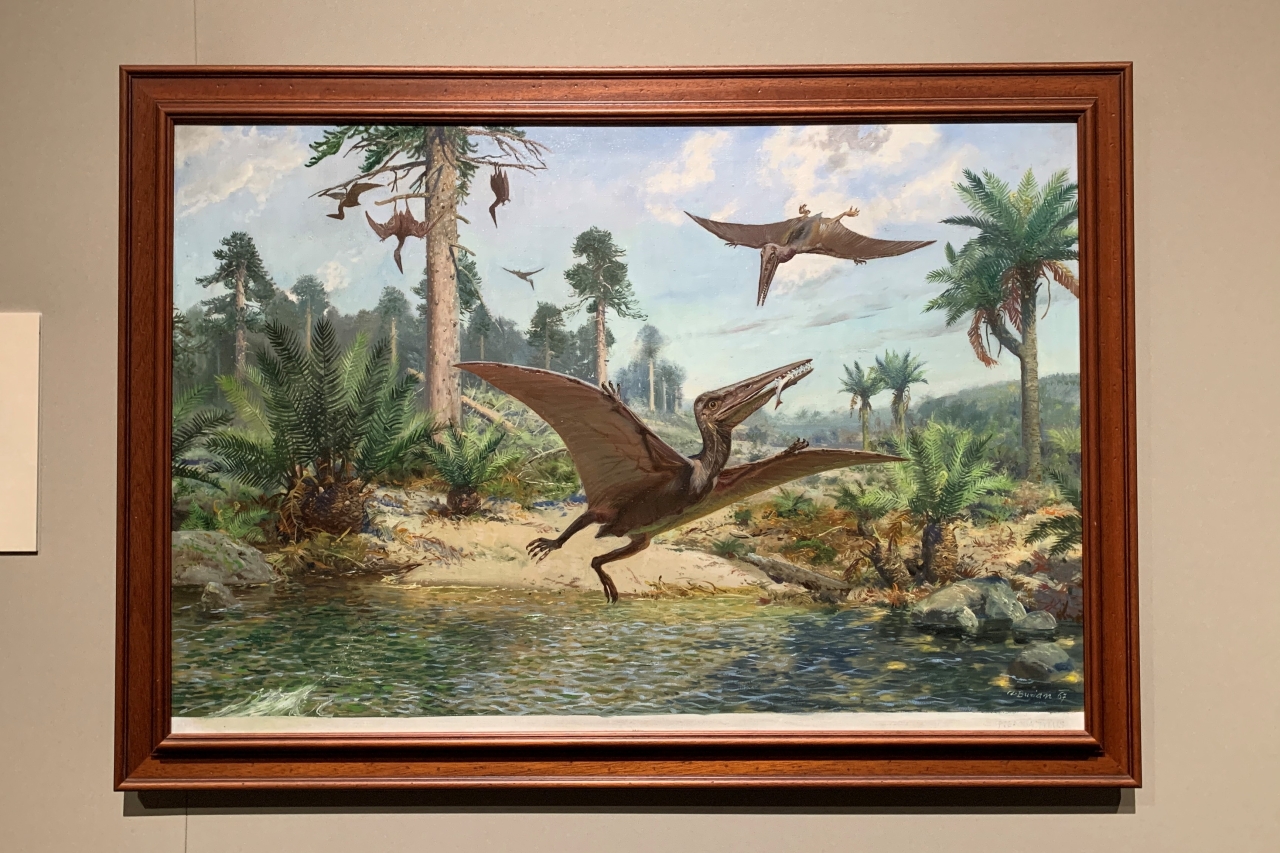
Zdenek Brian, Pterodactylus elegans, 1967, Dvor Kralove Zoo
In the past, it was not possible to determine the color of dinosaurs from fossils, so artists used their own guesses to color them. The contrast of te … is strongly impressed. The Stegosaurus in Antrodemus Valens and Stegosaurus Stenopus (1950) is probably one of the sources of that image. I was able to realize the magnitude of Brian's influence.
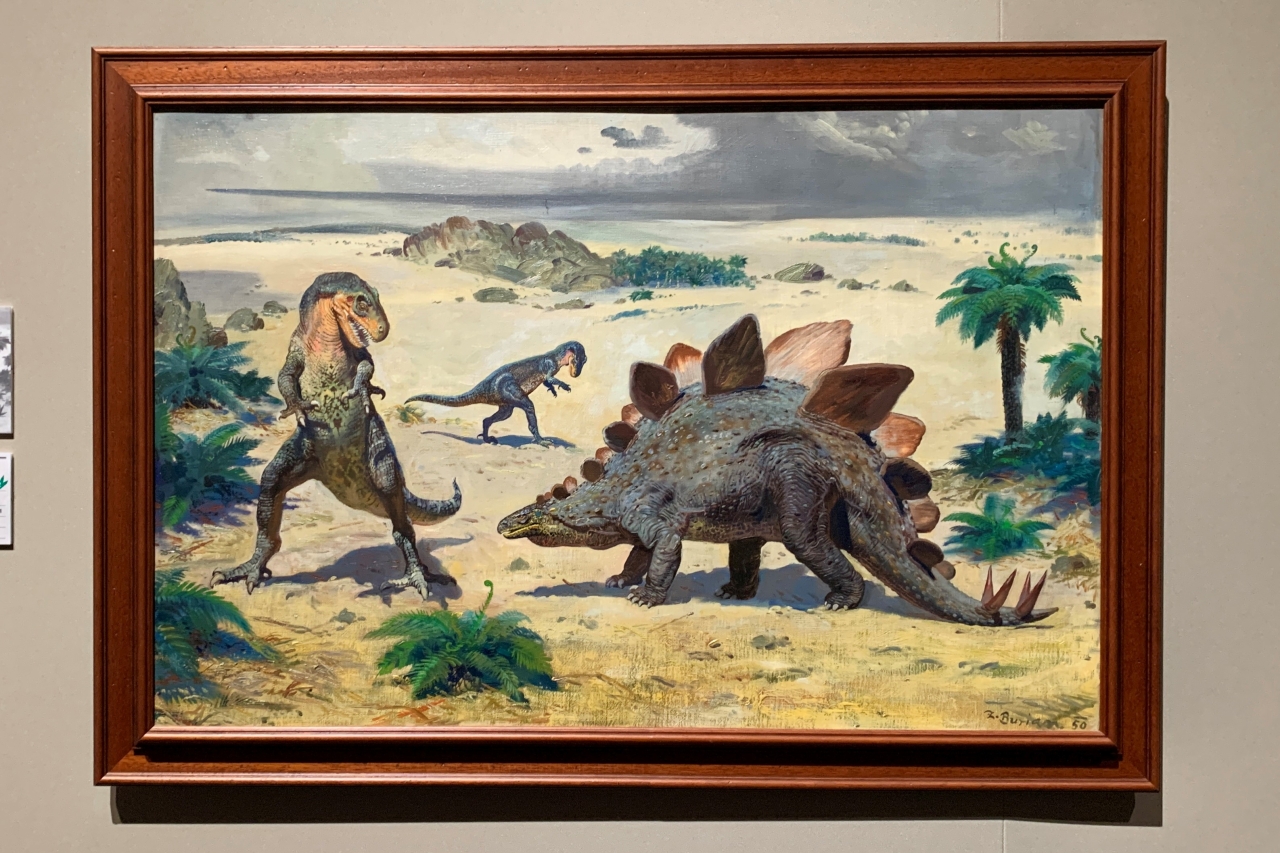
Zdenek Briand, Antrodemus Valens and Stegosaurus Stenopus, 1950, Dvor Kralove Zoo
This exhibition brings together 18 precious Briand works. It is the biggest attraction.
Also, in the same chapter, we can admire the majestic figure of the past of Hypsilophodon, which was popular as a "tree-climbing dinosaur" but later discovered that the restoration itself, which was the basis of research in the first place, was wrong.
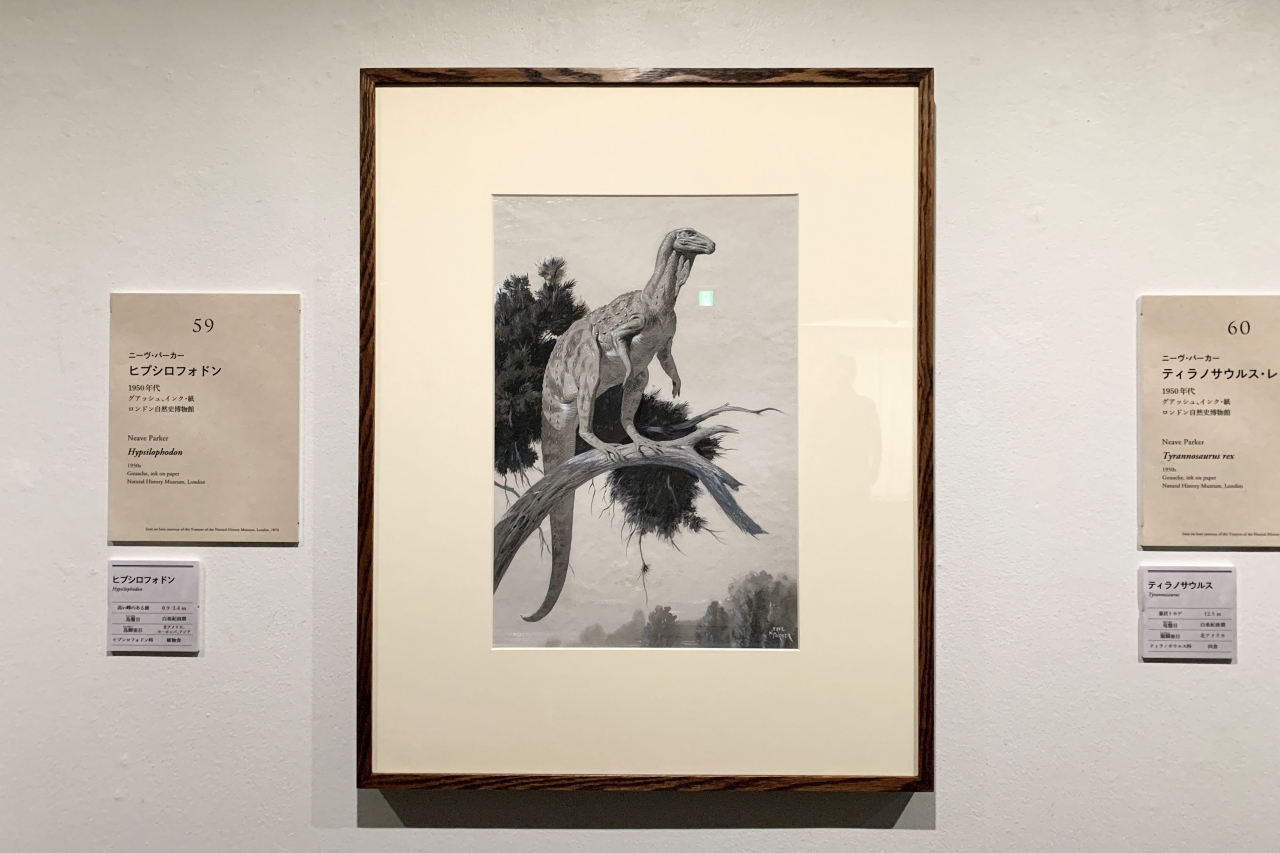
The gallant profile invites melancholy now. / Neve Parker, Hypsilophodon, 1950s, Natural History Museum, London
Chapter 3 "History of Reception of Dinosaurs in Japan"
The image of dinosaurs that was established in Europe and the United States entered Japan at the end of the 19th century. Chapter 3, "History of Reception of Dinosaurs in Japan," changes direction and introduces dinosaurs that were rooted in Japanese cultural history from the Meiji to Showa eras. In addition to science magazines, children's comics, and classic science fiction translations such as Conan Doyle's The Lost World (1912), toys such as soft vinyl dolls and plaster figurines imitating dinosaurs are also on display. .
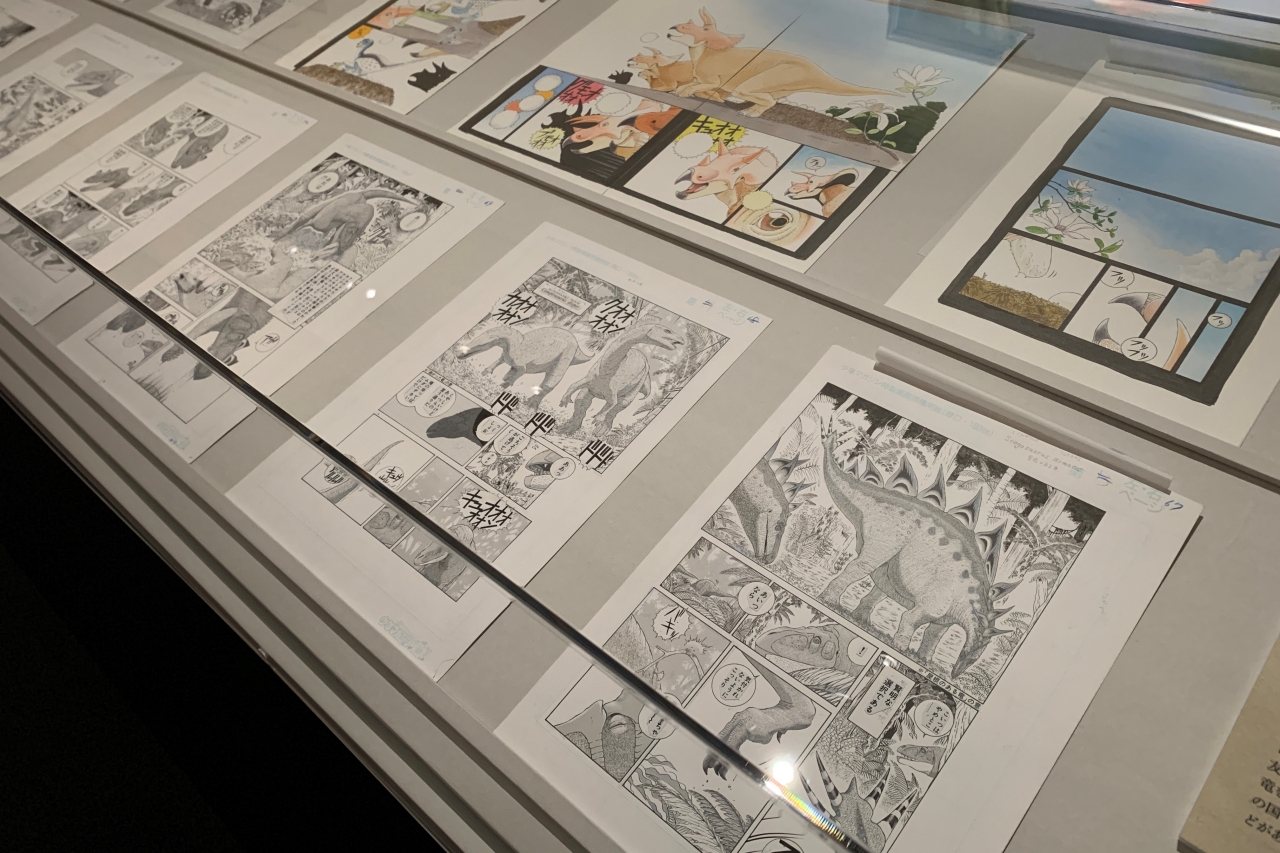
Valuable original drawing of "DINO²", the representative work of Juzo Tokoro, who has worked on numerous dinosaur-themed comics. / Tokoro Juzo "DINO²" Manga manuscript, 2002, owned by the artist
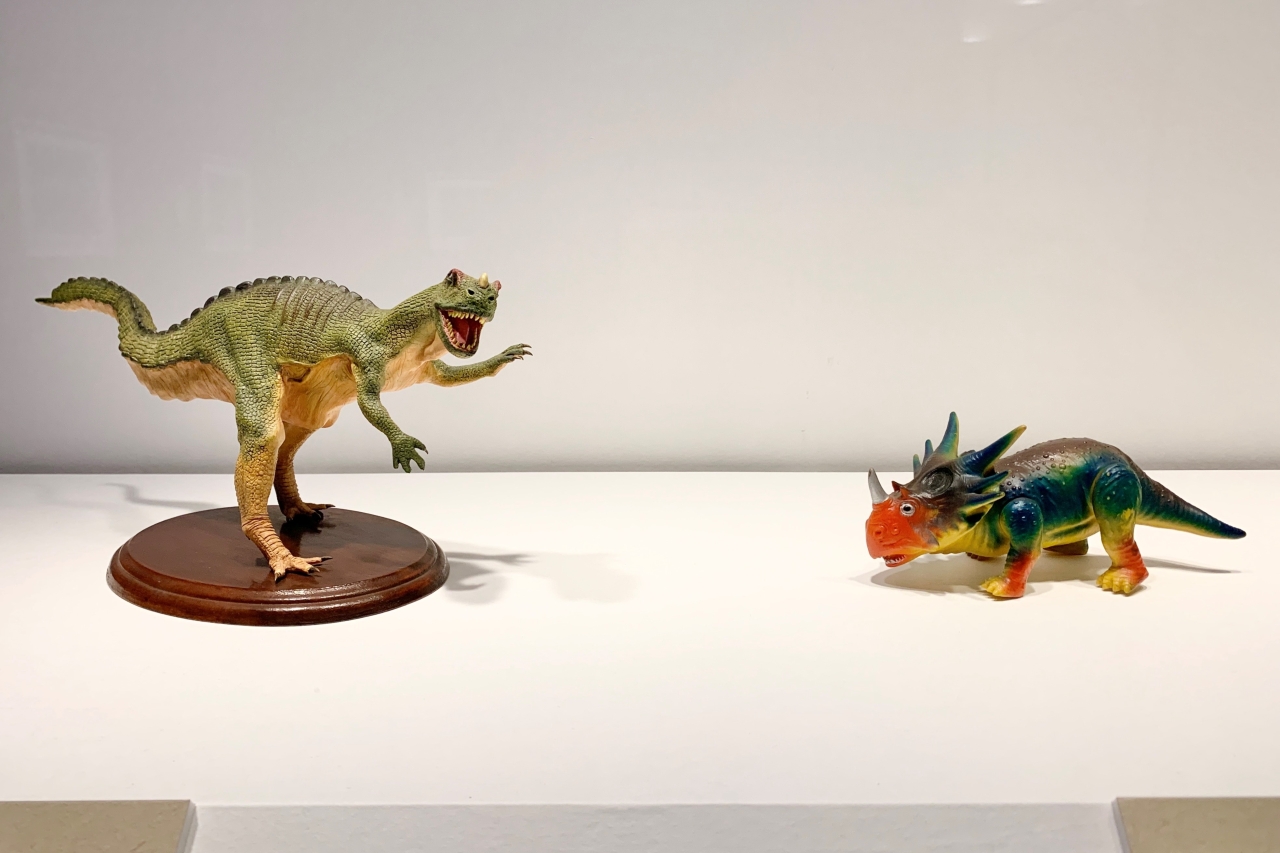
Left/Kazunari Araki/Kaiyodo, Plastic Model Kit (Ceratosaurus), 1978, Hiroshi Tamura Collection
Right / Marushin 《Soft Vinyl Doll (Styracosaurus)》 Hiroshi Tamura Collection
In addition, he also explains the symbolism of dinosaurs in the realm of general art, so-called fine art, whose purpose is not to realistically reproduce dinosaurs. (Some works from Heisei to Reiwa are also included)
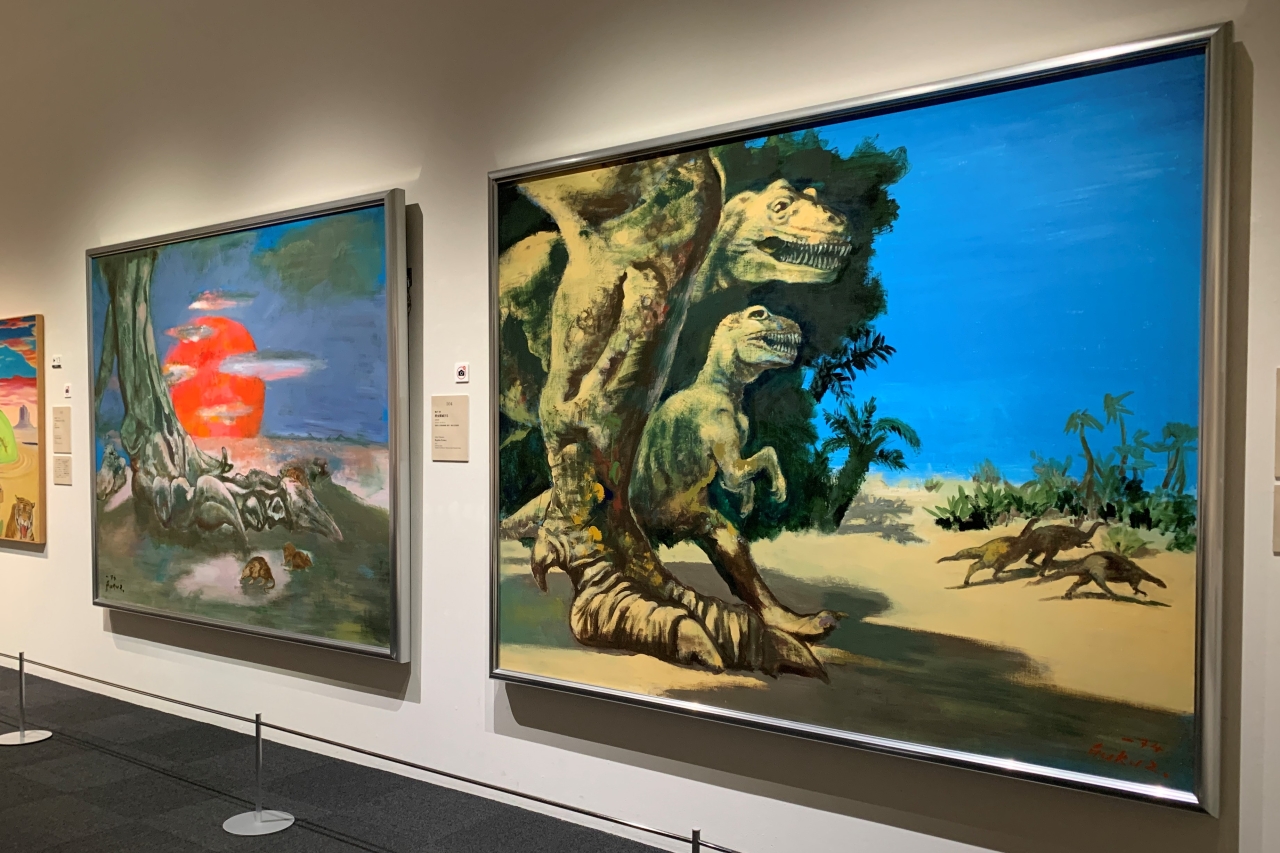
Ichiro Fukuzawa, Perishing Reptiles (left), Rising Reptiles (right), 1974, Tomioka City Museum of Art and Ichiro Fukuzawa Memorial Museum of Art
Ichiro Fukuzawa, who brought surrealism to Japan and created many works that included social satire and criticism of civilization , Ichiro Fukuzawa's Reptiles Infested and Reptiles Perish (1974) are interesting in their composition, which boldly places dinosaur limbs in the main. The contrast between the intense colors of the blue sky and the setting sun, the ephemeral appearance of the giant beings that once boasted prosperity, and the appearance of small mammals flocking to take their place are said to satirize Japan's factional politics.

Ai Shinohara, From Cradle to Graveyard, 2010-2011, Crane Museum
Ai Shinohara 《From the Cradle to the Graveyard》 (2010-2011), which reminds us of the traditional image of “death and maiden” in Western painting, where no matter how beautiful a girl is, cannot escape old age and death; Hiroshi Fuji, Jurassic Plastic (2023) , reminds us that petroleum, the raw material of plastic, was originally the fossil of dinosaurs and other creatures, and at the same time, considers the problem of mass production and mass consumption. ), etc., were all large-scale and worth seeing.
Chapter 4 "Reconstruction of image based on scientific knowledge"
In Chapter 4, "Reconstruction of images based on scientific knowledge," the topic returns to the changes in images of dinosaurs. Dinosaur research from the 1960s to the 1970s saw a revolution called the "Dinosaur Renaissance," in which the view that dinosaurs were "active warm-blooded animals" rather than slow poikilotherms as previously thought was presented. Dinosaur statues have been greatly redesigned. One after another, works that expressed the appearance of new dinosaurs were born.
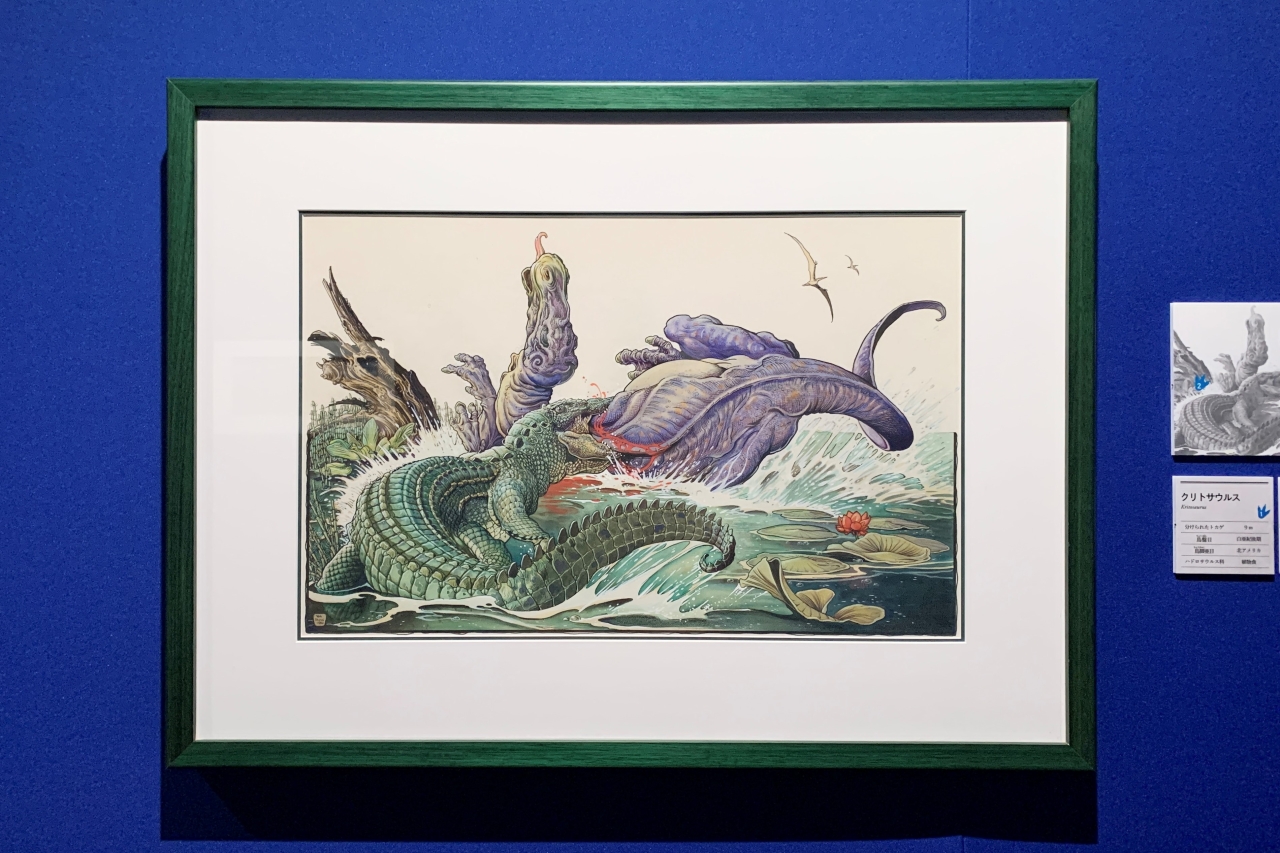
William Stout, Murder in the Marsh – Phobossuchus Attacking Kritosaurus, 1980, Fukui Prefectural Dinosaur Museum
In the exhibition, illustrator William Stout , who boasts a cult-like popularity even in the field of fantasy art, and Michael Tursic , who worked on the three-dimensional model of the movie "Jurassic Park", and an accurate and powerful touch of dinosaurs based on art anatomy. A wide variety of works by talented paleo artists who have appeared since 1960, such as Takashi Oda , the leading artist of paleo-creature restoration paintings in modern Japan, will be competing.
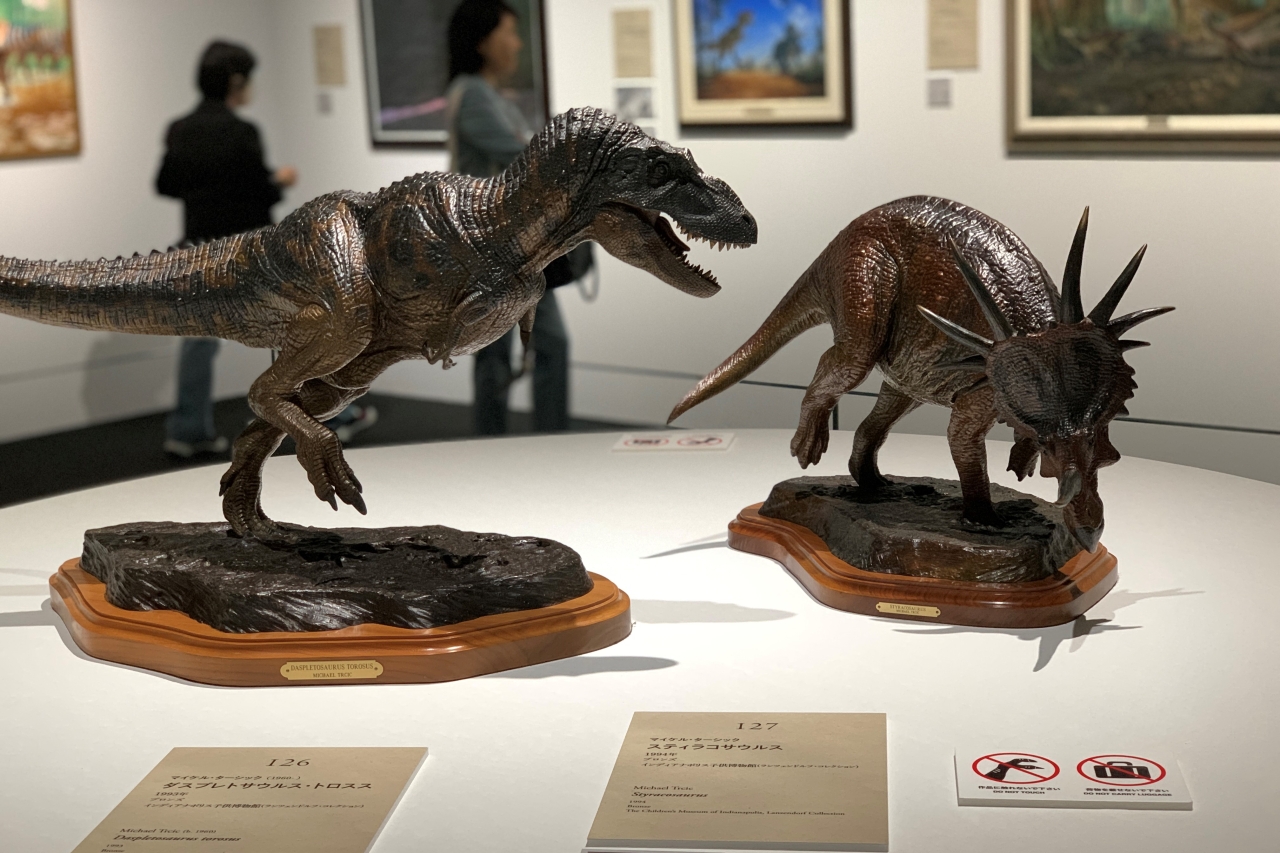
Left/Michael Tarsik, Daspletosaurus Throsus, 1993, Indianapolis Children's Museum (Lanzendorff Collection)
Right/Michael Tarsik, Styracosaurus, 1994, Indianapolis Children's Museum (Lanzendorff Collection)
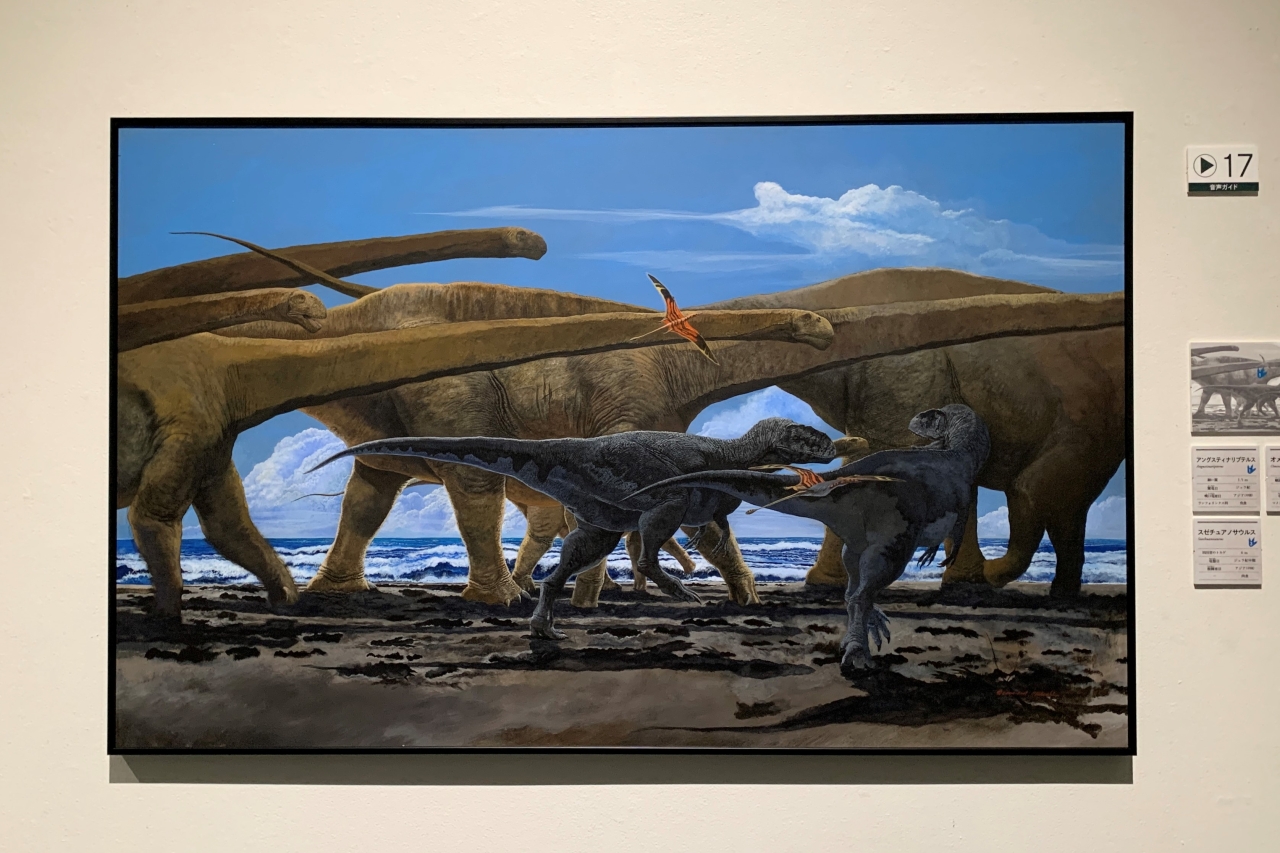
Takashi Oda, Pursuit 1, 2000-2001, Gunma Prefectural Museum of Natural History
Contemporary artists are making dinosaurs move with agility. John Bindon's "The Front of the Storm" (1996), in which a tyrannosaurus runs at a tremendous speed while raising water splashes, and Gregory Paul 's "Shichipachi and Sauro," which seems to capture the moment when dinosaurs start moving all at once, whether they are friends or foes. Lunithoides (1989) and others have a different sense of dynamism compared to the dinosaurs seen in Chapter 2.

John Bindon, Storm Front, 1996, Indianapolis Children's Museum (Lanzendorff Collection)
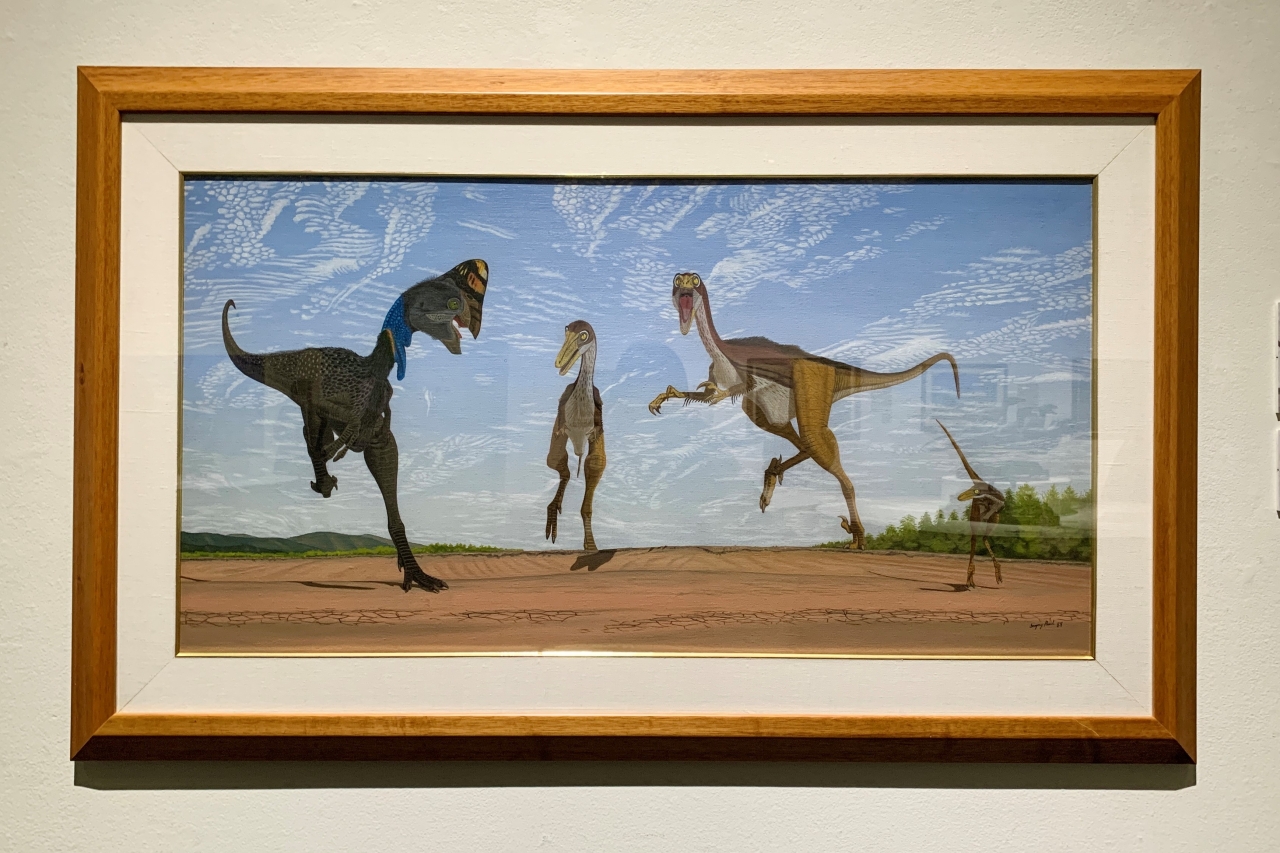
Gregory Paul, Chippachi and Saurornithoides, 1989, Fukui Prefectural Dinosaur Museum
I have the impression that the individuality of the works is also strong. Douglas Henderson 's works, which are breathtakingly beautiful and lyrical pastels, precisely expressing the light and air of the ancient world, are like looking at a high-quality photo book.
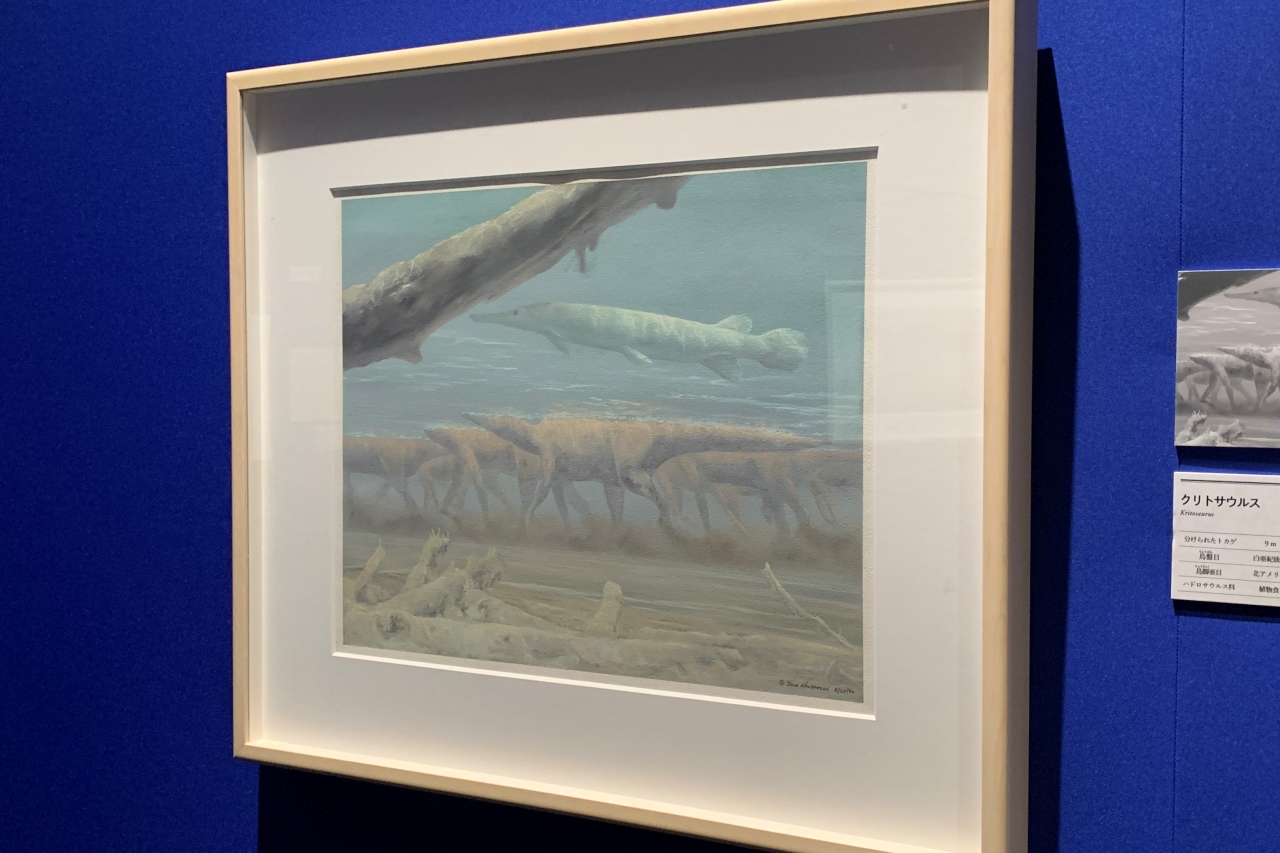
The new perspective is eye-catching, such as drawing only the limbs of Kritosaurus walking in the water. / Douglas Henderson, Kritosaurus and Gar, 1990, Fukui Prefectural Dinosaur Museum
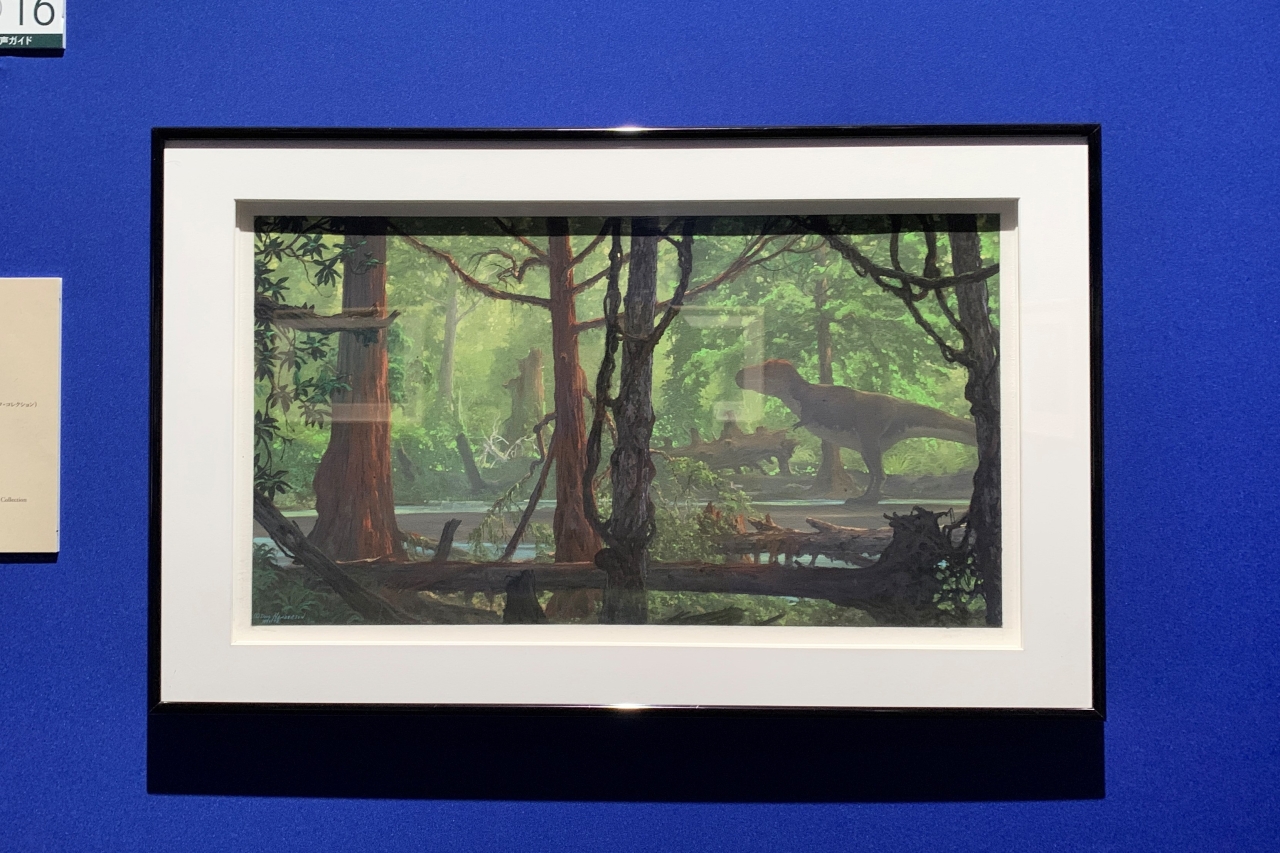
All of Henderson's works have a tranquil atmosphere. / Douglas Henderson, Tyrannosaurus, 1992, Indianapolis Children's Museum (Lanzendorff Collection)
While many painters focus on the dinosaurs themselves, Henderson has a strong tendency to depict dinosaurs together with the environment in which they lived at the time. situation. I draw so that it blends into the scenery without focusing.
I was completely drawn into the clever composition, which overlapped with common memories such as when I was trying to shoot a sunset and a bird was accidentally captured, or when I was walking in the forest and found a squirrel in the depths of the trees.

Left/Hirokazu Tokugawa, Sasayama Group Tyrannosauroid, 2015, Tamba City Tamba Dragon Fossil Studio
Right/Hirokazu Tokugawa, Tambatitanis amykitiae, 2013, Tamba City Tamba Dragon Fossil Studio
As academic knowledge increases, the special exhibition "Dinosaur Encyclopedia-Imagination/Creation of the Lost World" will be held until Saturday, July 22, 2023. . Of course, the contents will stir up the romance of the ancient world, and it is a rare opportunity to see paleo art that straddles the ages, so please check it out.
Overview of the special exhibition “Dinosaur Encyclopedia – Imagination/Creation of the Lost World”
| exhibition period | Wednesday, May 31, 2023 to Saturday, July 22, 2023 * Open every day during the exhibition period |
| venue | Ueno Royal Museum |
| Opening hours | 10:00 – 17:00 (9:30 – 17:00 on weekends and holidays) *Admission until 30 minutes before closing |
| Viewing fee (tax included) | General 2,300 yen, university/vocational school students 1,600 yen, high/junior high school/elementary school students 1,000 yen
* Free for preschoolers (must be accompanied by a high school student or older) |
| organizer | Sankei Shimbun, Fuji Television Network, The Ueno Royal Museum |
| inquiry | Hello dial 050-5541-8600 (all day/9:00-20:00) |
| Official site | https://kyoryu-zukan.jp/ |
*The content of the article is as of the interview date (May 30, 2023). Please check the official website for the latest information.


